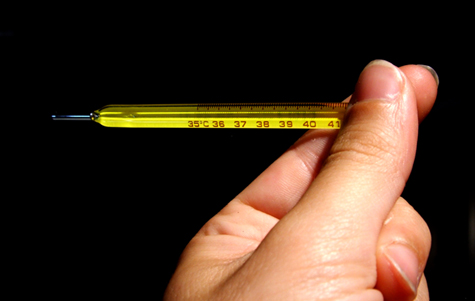Human Body Temperature is the state of hotness of body or the degree of heat of body. The human body is normally maintained in a state of hotness called normal body temperature, which is 98.6°F or 37°C. During certain abnormal conditions of body or part of body the temperature increases or decreases. In certain condition the temperature may go up or down to alarming condition thus requiring proper measurement to take due steps to bring body to normal temperature either by physical methods or by medications.

Purpose of measuring temperature
- To know the normal or abnormal temperature of body during illness.
- To assist doctor to reach a diagnosis.
- To give some injection or I.V. Therapy or blood transfusion.
- To assess the effect of treatment provided by doctors.
- To administer anti-pyretic or analgesics or oral vaccines to children.
Places for taking temperature
- Oral, below tongue.
- In axilla.
- In Inguinal region or groin
- In rectumNormally oral temperature is taken as normal body temperature. One degree Fahrenheit is to be added to axilla and groin temperature. Rectal temperature is said to be ideal temperature of body which is always little higher (about 1 degree F than oral temperature).Universals General instruction of taking Human Body Temperature For Doctors And nurses
- Thermometer should be cleaned in cold water before use.
- It should be brought below normal body temperature 37°C or 98.6°F before taking temperature.
- The patient should be informed about the procedure and place of insertion.
- The temperature should not be taken just after taking food or drinks may be cold or hot when oral temperature is taken.
- The thermometer should be placed in such a way that a comes in proper contact to the body tissue or organ.
- Normally it should be placed for 2 minutes.
- Wait 10-30 minutes after food or liquid taken by patient.
- Do not take temperature if patient is breathless, or during disease or injury to mouth or during convulsion.
Precautions of Taking Temperature
- Wait 10-30 minutes after food or liquid taken by patient.
- Do not take temperature if patient is breathless, or during disease or injury to mouth or during convulsion.
- Never handle thermometer by bulb.
- If a child or adult patient bites or breaks thermometer in mouth never be panic as mercury in thermometer is in metallic base form which is harmless if taken to stomach. Oxides of Mer Metallic poisonous not metallic mercury. Simply clean the glass pieces from mouth by cotton pieces. You can give egg of white to the patient for emulsification action and easy removal by stool. Inform the mater to senior staff and doctor.
- Temperature below 97°F or above 100°F should be intimated.
- Never take oral and rectal temperature at the same time.
- Never use 01 al thermometer for rectal use or vice versa. Rectal thermometer is different in make than oral thermometer.
- Never tell the patient regarding his temperature.
- Time of taking temperature
- Just after admission of a patient in hospital.
- Routinely every 4 hourly—6 am, 10 am, 2 pm and 6 pm.
- Sometimes 2 hourly even during sleep when specially instructed by doctor.
- very 4 hourly for first 48 hours after operation
.Before and after certain nursing procedures like blood transfusion, serum administration, cold sponging, temperature reduction enema. - Immediately after chill.
During any collapsing stage.
Checking body temperature is a straightforward process, but it’s important to follow the correct steps to ensure an accurate reading. Here’s a guide in a tabular format:
| Step | Description | Tips |
|---|---|---|
| 1. | Choose a thermometer | Digital thermometers are recommended for accuracy and ease of use. |
| 2. | Prepare the thermometer | Clean it with alcohol or soapy water, then rinse and dry. |
| 3. | Select an appropriate site | Common sites are oral, rectal, armpit, and ear. Each site may have slightly different readings. |
| 4. | Position the thermometer | Place it correctly depending on the chosen site (e.g., under the tongue for oral readings). |
| 5. | Wait for a stable reading | Digital thermometers usually beep when the reading is stable. |
| 6. | Read and record the temperature | Note the reading and the time of day. |
| 7. | Clean the thermometer after use | Clean and disinfect to prepare it for next use. |
| 8. | Interpret the results | Normal body temperature ranges from 97°F (36.1°C) to 99°F (37.2°C). Consider factors like time of day and method of measurement. |
| 9. | Follow up if necessary | Seek medical advice if the temperature is unusually high or low or if there are symptoms of illness. |
Notes:
- Always read and follow the thermometer’s instructions for the most accurate results.
- The method of measurement might affect the reading; for instance, rectal temperatures are generally higher than oral readings.
- If you’re using a mercury thermometer, handle it with care to avoid breakage and mercury exposure.
